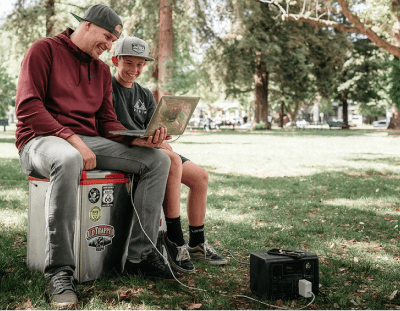Things to know about your 12v portable battery: In an age when we can charge our smartphones with a battery pack that fits inside a pants pocket, shouldn't there be a simpler way to restore power in the wake of a storm? Or, say, power a campsite without the constant hum of a gas-fueled generator? When duty calls, you can safely run a portable power station inside, since it doesn't generate any emissions. They have enough capacity to power a few small appliances for a short time.
With a host of different outlets (standard 120v outlets, USB ports, and DC chargers), you can use the station to charge electronics, too. And the units often come with portable solar panels, to add more charging capabilities and extend runtime.
Such is the promise of portable power stations, also known as battery-powered inverter generators. Essentially, they're oversized rechargeable batteries-about the size of a countertop microwave oven-that you plug into a typical 110-volt outlet to top off.
1. They Can 't Deliver Nearly as Much Power as Gas Generators
As with their gasoline-fueled counterparts, portable power stations require a transfer switch should you wish to power things such as your furnace, overhead lights, or any thing else in your home that 's hardwired.
But while a recreational inverter generator would probably keep the TV and a few lights on for 8 to 13 hours on one tank of gas, you'd see anywhere from 3 to 9 hours of power, under the same circumstances, with a portable power station.
And you won't be able to run, for instance, your power-guzzling well pump.
2. They Take Awhile to Charge
In our tests, most of these models require hours of charging (typically overnight) to provide you with a full battery and max runtime.
So-assuming you fully charged the battery before a predicted weather event-a portable power station could give you hours of electricity to run a refrigerator or another essential appliance.
But Trezza notes that once the battery is dead, if you 're without power and minimal sun, there 's no way to recharge.
3. Charging With Solar Panels Can Be Iffy and Lengthy
If you're dealing with an outage or you're otherwise off the grid, charging the power station via solar panels is your only option-and that's provided you have good sun and no obstructions.
In our tests, we found that the solar panels can add to the runtime, but that might only amount to an extra hour or two of power with larger appliances.
4. They 're Not All That Portable
Portable power stations are about the size of an average microwave oven, but they're fairly heavy-most in our tests weigh more than 80 pounds.
That means you'll likely need an extra pair of hands to lift one into the trunk of your car. Some of the models come with wheels, but not all wheels are large in size, which makes rolling them across a lawn difficult.
5. They Don 't Come Cheap
The portable power stations we tested cost between $1,500 and $3,500. And our best portable gas generator costs less than the worst portable power station.
Before buying one of these power stations, consider if you might be better served by a portable generator. In the event of a outage, you can continue to add fuel, and portable generators typically provide enough power to keep larger appliances running. Buying a 12v portable battery for the first time? It's not as overwhelming as you think. Just give us a call today anda member of our sales team will get back to you and help you out with your purchase.








